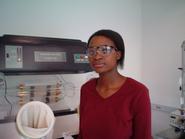
Hydrate inclusion compounds are compounds in which water crystallizes to form "cages," for example, hydrogen-bonded host lattices, that can physically enclose, on the atomic scale, other molecules, called "guests. The semi-clathrate hydrates are one type of hydrate inclusion compound. As their name implies, the semi-clathrates are only partial inclusion compounds because parts of their water cages are broken to accommodate large guest molecules. Fallon Chipidza '10 (Harare, Zimbabwe) is working with Assistant Professor of Chemistry Camille Jones with several semi-clathrate hydrates to more closely analyze the water-guest relationship in these inclusion compounds. Her goal is to determine the exact water of hydration for three guest molecules: tetra-n-butyl ammonium fluoride (TBAF), chloride (TBAC), and bromide (TBAB). The term "water of hydration" refers to water molecules that are chemically combined with the salts in such a way that they can be removed by physical means without substantially changing the chemical composition of the salts.
When Chipidza began her research project, she thought that her task for the summer would be easy because all she needed to do was find the weight of the hydrated salt (i.e. salt + water), remove the water, and then measure the weight of the salt alone to determine how many water molecules were part of the original hydrate. She soon discovered, however, that what seems simple in theory can actually be a very difficult procedure in reality. Chipidza's semi-clathrates only exist at very low temperatures, and, if they are not kept in a cold environment, they will rapidly absorb moisture from the environment. Thus, many traditional dehydration methods could not be used because the clathrate relationship would be destroyed before any measurements could be made. Thus, Chipidza has had to utilize more creative methods. Although the TBAB and TBAC hydrates were susceptible to freeze drying, the TBAF hydrate was not, indicating that the water molecules might be more strongly attached to the TBAF guest molecule. Despite her use of many other techniques, TBAF hydrate still presents Chipidiza with a major challenge.
Once Chipidza dehydrates her semi-clathrate compounds, she is able to more closely analyze their structure using three techniques: neutron scattering, basic gravitometry and X-Ray diffraction. Using X-ray diffraction, she studies the structures of both the hydrated and dehydrated TBA salts and then uses a computer program called ATOMS to model them in 3D. Chipidza and Jones have also traveled to the National Institute of Standards and Technology (NIST) in Maryland to analyze the TBA salts using Neutron Scattering methods. They plan to travel back to Maryland before the end of summer to analyze more samples that Chipidza is currently creating.
This is Chipidza's first summer of research. She is currently contemplating a possible chemistry and economics double major. On campus, Chipidza is actively involved in many organizations. She is the secretary of the West Indian and African Association, a member of the Christian Fellowship, and an RA. She also sings in the Gospel choir and plays intramural volleyball. Starting this fall, Chipidza will be hosting the ESOL radio show as well as co-hosting the African radio show with Sakhile Matlhare `10 on WHCL.
--by Nick Berry '09
When Chipidza began her research project, she thought that her task for the summer would be easy because all she needed to do was find the weight of the hydrated salt (i.e. salt + water), remove the water, and then measure the weight of the salt alone to determine how many water molecules were part of the original hydrate. She soon discovered, however, that what seems simple in theory can actually be a very difficult procedure in reality. Chipidza's semi-clathrates only exist at very low temperatures, and, if they are not kept in a cold environment, they will rapidly absorb moisture from the environment. Thus, many traditional dehydration methods could not be used because the clathrate relationship would be destroyed before any measurements could be made. Thus, Chipidza has had to utilize more creative methods. Although the TBAB and TBAC hydrates were susceptible to freeze drying, the TBAF hydrate was not, indicating that the water molecules might be more strongly attached to the TBAF guest molecule. Despite her use of many other techniques, TBAF hydrate still presents Chipidiza with a major challenge.
Once Chipidza dehydrates her semi-clathrate compounds, she is able to more closely analyze their structure using three techniques: neutron scattering, basic gravitometry and X-Ray diffraction. Using X-ray diffraction, she studies the structures of both the hydrated and dehydrated TBA salts and then uses a computer program called ATOMS to model them in 3D. Chipidza and Jones have also traveled to the National Institute of Standards and Technology (NIST) in Maryland to analyze the TBA salts using Neutron Scattering methods. They plan to travel back to Maryland before the end of summer to analyze more samples that Chipidza is currently creating.
This is Chipidza's first summer of research. She is currently contemplating a possible chemistry and economics double major. On campus, Chipidza is actively involved in many organizations. She is the secretary of the West Indian and African Association, a member of the Christian Fellowship, and an RA. She also sings in the Gospel choir and plays intramural volleyball. Starting this fall, Chipidza will be hosting the ESOL radio show as well as co-hosting the African radio show with Sakhile Matlhare `10 on WHCL.
--by Nick Berry '09
Posted July 19, 2007
